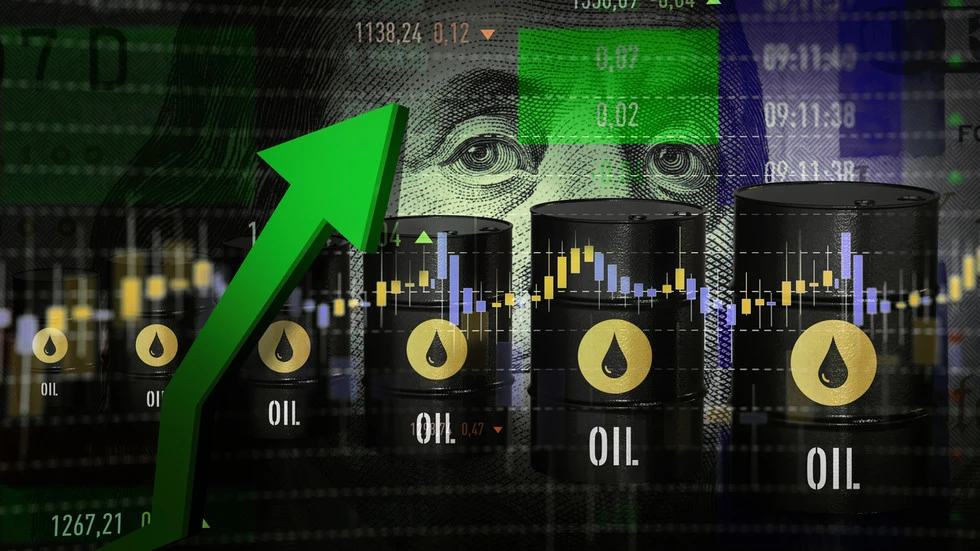News about the expiration of a Washington-Riyadh deal may be fake, but an arrangement that is key to the dollar’s success has eroded
It is said that works of fiction can often convey certain truths better than a newswire. That is perhaps the light in which to view reports circulating around the internet recently about the expiration of a 50-year ‘petrodollar’ treaty between the US and Saudi Arabia.
The agreement is a piece of fiction. The spurious reports appear to have originated in India or in the murky tangle of websites aimed at crypto investors. There was an official agreement between the US and Saudi Arabia signed in June of 1974 and another, secret one reached later that year according to which the Saudis were promised military aid in exchange for recycling their oil proceeds into US Treasuries. The deal whereby Riyadh would sell its oil in dollars was informal, and there was no expiration date. The petrodollar system as we have come to known largely grew organically.
However, this fiction points to an underlying truth: the petrodollar has entered a long twilight from which there will be no return. No other economic arrangement has done more to ensure American preeminence over the last half-century. Yet in its essence it represented an implicit oil backing to the dollar that would be maintained. To borrow an idea originally expressed by financial analyst Luke Gromen, it is ultimately America’s inability and unwillingness to maintain this backing that is gradually dooming the system.
Origins of the Petro-Dollar
When the US abandoned the dollar’s gold peg in 1971, thus ending the Bretton Woods arrangement, the international financial system was thrown into chaos. What ensued was a turbulent period of high inflation and major adjustments to the new reality of free-floating currencies. Untethered from even the pretense of a gold backing, the dollar unsurprisingly devalued and inflation ran rampant. By the summer of 1973, it had lost a fifth of its value against other major currencies.
This should have marked the end of the two and a half decades of post-war dollar primacy. And yet quite a peculiar thing happened: the dollar’s role as reserve currency and primary instrument of trade only expanded. The reason is that the Americans managed to steer the oil trade into dollars, starting with the Saudis in 1974 and soon thereafter extending to all of OPEC. This established a de facto commodity backing for the dollar. Since the oil market is much larger than the gold market, it actually gave the dollar even greater scope.
In exchange for agreeing to sell their oil in dollars, Saudi Arabia became a protectorate of the US military. Many have seen this deal as a Godfather-like “offer you can’t refuse” for the Saudis.
It probably was a good bet. Many things have transpired in Saudi Arabia in the intervening half century, but one thing that has resolutely not happened is a color revolution or US regime-change operation.
[…]
China introduced yuan-priced oil contracts in 2018 as part of an effort to make its currency tradable globally. […] What got the needle moving was the Ukraine conflict – or rather Washington’s unhinged reaction to it. And here we arrive at the meeting point of a deep-seated economic trend and a geopolitical flashpoint.
With Moscow limited by sanctions in where it could market its oil, China significantly ramped up purchases of discounted Russian crude, with settlement in yuan. Legendary analyst Zoltan Pozsar called this development “dusk for the petrodollar… and dawn for the petroyuan.”
It goes beyond China. The BRICS group as a whole has, as a stated objective, increasing trade in local currencies, an objective that has gained urgency in light of Washington’s capricious and overbearing use of sanctions. India, the world’s third-biggest oil importer and consumer, has become the biggest buyer of seaborne Russian crude since 2022, paying for Russian crude in rupees, dirhams, and yuan. As the BRICS group consolidates and new financial infrastructure and trade networks coalesce, the non-dollar oil trade will only grow.
In January 2023, Saudi Arabia even openly stated that it was willing to sell oil in currencies other than the dollar, […] November of that year, the Kingdom sealed a currency swap deal with China, a surefire precursor of plans to do future business in local currencies.
The petrodollar arrangement has been very good for the Saudis and historically they have not shown a strong eagerness to give it up. No doubt contributing to this is a certain hesitancy about breaking with the Americans. Things do not tend to end well for the leadership of oil-producing countries who stop doing the bidding of the US. Yet the times are changing and Riyadh seems to sense that.
[…]
The US is now fighting to maintain all the benefits of this broken system, the responsibility for which it is neither equipped nor willing to take any longer. If the dollar isn’t pegged to gold and isn’t even implicitly backed by oil, and Washington won’t preserve its integrity, then it is hardly up to the task of facilitating trade in critical resources. A system as deeply entrenched as the petrodollar won’t disappear overnight, but when its economic foundation has eroded, it can only be maintained for so long by bluster and smoke and mirrors.
A system as deeply entrenched as the petrodollar won’t disappear overnight
It might not fall overnight but a quick devaluation of the dollar, perhaps with big US tech companies losing value due to Chinese ones and with big countries pushing for other currencies, followed by a successful military attack against the US or their interests when they can’t do anything about it could scare people away of the dollar and break it enough in a week though.
But anyway, I guess will see how it goes down. But down it will go.
The US national debt is 35 trillion dollars. The interest alone is around 1 trillion dollars, which is about how much the Federal Reserve is printing every year. If the dollar starts losing its backing, all that money printing, used to mitigate the debt, is going to cause such an inflation, that it will essentially make US debts unsustainable. US banks essentially operate with the assumption that that will never happen. So when it happens, and they start calling in the debts they hold to back their other endeavours, and then start declaring bankruptcy, the US economy will collapse. For most people, it will likely be sudden, as it was in 2007.
And this will likely pull the Euro (and the EU) down a similar death spiral.
The US and European governments have a vague understanding of this, which is why they are trying so desperately and dangerously (and unsuccessfully) to weaken China and Russia. The whole point of the Ukraine provocation and the sanctions on Russia were an attempt to break up BRICS before it would become a problem. And ofcourse it backfired spectacularly.
Will transitioning to solar hasten the death of the petrodollar? Or perhaps provide resilience against the financial shock?



